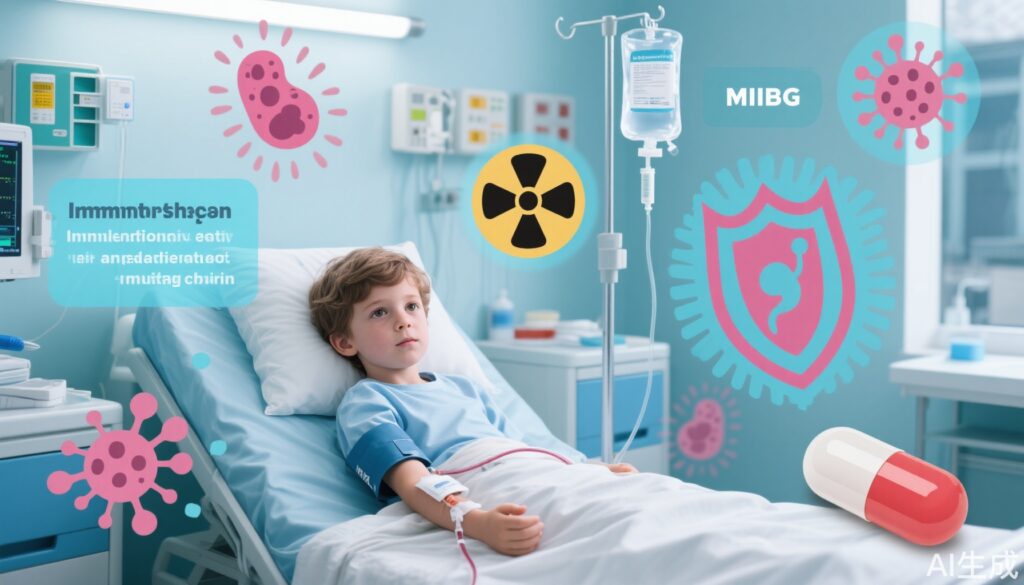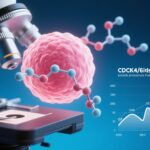Highlights
- First-in-human phase I trial of a triple therapy (MIBG, dinutuximab, vorinostat) for relapsed/refractory neuroblastoma achieves disease control in up to 75% of evaluable patients.
- Combination therapy demonstrates manageable safety profile, with no new or unexpected toxicities.
- Mechanistic synergy: targeted radiotherapy (MIBG), immunotherapy (anti-GD2 antibody), and epigenetic modulation (vorinostat) collectively enhance anti-tumor efficacy.
- Encouraging results pave the way for larger, randomized phase II trials and biomarker-driven personalized strategies.
Study Background and Disease Burden
Neuroblastoma is the most common extracranial solid tumor in children, accounting for about 8-10% of all childhood cancers. The disease typically arises from the adrenal medulla or sympathetic ganglia, manifesting as tumors in bone, soft tissue, or other organs. Despite advances in multimodal therapy, patients with relapsed or refractory neuroblastoma (rNBL) have a dismal prognosis. Current frontline regimens for rNBL incorporate the anti-GD2 monoclonal antibody dinutuximab with chemotherapy and cytokines. However, remission remains elusive for approximately half of patients, largely due to the immunosuppressive tumor microenvironment and the inability of conventional radiotherapy to target disseminated disease. Thus, innovative systemic strategies are urgently needed.
Study Design
This phase I, open-label, multi-center trial (Cash et al., JCO 2025) enrolled 45 pediatric and young adult patients (median age 7.5 years, range 2.9-24.1) with relapsed or refractory neuroblastoma and MIBG-avid lesions. The design utilized a two-part schema:
– Part A (n=19): Patients received intravenous 131I-metaiodobenzylguanidine (MIBG, 12-18 mCi/kg) on day 1 using the rolling six dose-escalation method, followed by dinutuximab (17.5 mg/m², IV, days 8-11 and 29-32), GM-CSF (250 mcg/m², SC, days 8-17 and 29-38), and autologous stem cell infusion on day 15.
– Part B (n=12): Patients received vorinostat (180 mg/m², oral, days 0-13) in combination with the recommended phase II dose (RP2D) from Part A, with up to two treatment cycles permitted.
Primary endpoints were dose-limiting toxicity (DLT) and recommended phase II dose. Secondary endpoints included best overall response rate (BORR), disease control rate (DCR), and safety. Efficacy was evaluated according to the International Neuroblastoma Response Criteria.
Key Findings
Safety:
– In Part A, no DLTs were observed, establishing the RP2D for MIBG at 18 mCi/kg.
– In Part B, one DLT (grade 3 hypokalemia) occurred during the first cycle; in the second cycle, three patients experienced DLTs (grade 3 ALT elevation, grade 4 hypoxemia and grade 5 pneumonia, grade 3 fatigue).
– The most frequent ≥grade 3 adverse events were myelosuppression (78%), transaminase elevation (22%), and hypoxemia (8%). These were consistent with known toxicities of the individual agents; no new safety signals emerged.
Efficacy:
– Among 31 evaluable patients, Part A (MIBG + dinutuximab) achieved a BORR of 42% (including 16.7% complete responses), and a DCR (CR + PR + MR) of 46%, significantly outperforming historical single-agent benchmarks (~20%).
– In Part B (addition of vorinostat), the BORR was similarly 42%, but the DCR rose to 75% (CR/PR/MR), with no cases of progressive disease during the study window.
– Table 1 summarizes key efficacy outcomes:
| Group | Evaluable Patients | BORR (%) | DCR (%) | CR (%) | PD (%) |
|---|---|---|---|---|---|
| Part A | 19 | 42 | 46 | 16.7 | ~50 |
| Part B | 12 | 42 | 75 | Not stated | 0 |
Translational Mechanisms:
– MIBG delivers targeted systemic radiotherapy to neuroblastoma cells, exploiting their norepinephrine transporter expression.
– Dinutuximab (anti-GD2) mediates antibody-dependent cellular cytotoxicity.
– Vorinostat, a histone deacetylase inhibitor, epigenetically upregulates GD2 and modulates the tumor microenvironment to enhance immune response.
– The triple strategy thus attacks neuroblastoma through complementary mechanisms: direct cytotoxicity, immune activation, and microenvironment modulation.
Expert Commentary
This trial represents a significant proof-of-concept for multi-modal systemic therapy in high-risk rNBL. The 75% disease control rate in the triple-agent group, with no observed progression during the study period, is particularly impressive given the heavily pre-treated and refractory nature of the cohort. Importantly, the safety profile was manageable and consistent with existing agent-specific toxicities. These data suggest that rational combination therapy—targeting tumor cells, boosting immune effector function, and reprogramming the microenvironment—can substantially improve outcomes where monotherapies have failed.
However, caution is warranted in interpreting these findings. The sample size is modest, and as a phase I study, the primary aim was safety and dose-finding rather than definitive efficacy. Longer-term follow-up and randomized phase II/III data will be required to confirm durable benefit, optimal sequencing, and patient selection. Future research should also focus on identifying predictive biomarkers (such as GD2 expression levels or immune signatures) to personalize therapy.
Conclusion
The integration of MIBG, dinutuximab, and vorinostat marks an important step forward in the treatment of relapsed/refractory neuroblastoma. This triple therapy demonstrates encouraging early efficacy, with a substantial proportion of patients achieving disease control and manageable toxicity. Ongoing and planned randomized trials will be critical for validating these results and optimizing multi-agent regimens in this challenging pediatric population. For patients who have exhausted conventional options, this approach signals a new horizon for precision, multi-modal therapy.
References
1. Cash T, Marachelian A, DuBois SG, Chi YY, Baregamyan A, Groshen SG, Jonus HC, Shamirian A, Crowley M, Goodarzian F, Acharya PT, Pawel B, Erbe AK, Shahi A, Zaborek J, Kennedy E, Asgharzadeh S, Villablanca JG, Pinto N, Weiss BD, Mosse YP, Desai AV, Macy ME, Granger M, Vo KT, Sondel PM, Matthay KK, Park JR, Goldsmith KC. Phase I Study of 131I-Metaiodobenzylguanidine With Dinutuximab ± Vorinostat for Patients With Relapsed or Refractory Neuroblastoma: A New Approaches to Neuroblastoma Therapy Trial. J Clin Oncol. 2025 Aug;43(22):2490-2501. doi: 10.1200/JCO-24-02612.
2. Park JR, Kreissman SG, London WB, et al. Effect of tandem autologous stem cell transplant and anti-GD2 immunotherapy vs single transplant on event-free survival in patients with high-risk neuroblastoma: a randomized clinical trial. JAMA. 2019;322(8):746-755.
3. Matthay KK, et al. 131I-MIBG therapy of advanced neuroblastoma. Q J Nucl Med Mol Imaging. 2013;57(2):172-185.



